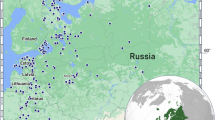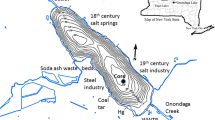Abstract
We describe a palaeolimnological meta-database (“LakeCores”) that includes information for lakes in Europe that have been cored for studies of recent environmental change. Only cores with intact mud-water interfaces and good chronologies for the last ~100–200 years are currently included. The information provided in the database includes the general characteristics of the lakes cored, the methods used for dating and analysis and the bibliographic source of the information selected. At present the database contains information on 1847 studies from 975 sites. Here we use the database to identify cores for which diatom-based pH and total phosphorus (TP) reconstructions have been derived and, from an inspection of the relevant papers, we compile summary data for the timing and extent of acidification and eutrophication of lakes across Europe. We show that there were few cases of acidification and eutrophication in Europe prior to about 1850, and therefore that conditions prior to 1850 can be used for reference with respect to current attempts to restore surface waters to “good ecological status”. We also show the extent to which pH and TP levels have changed across the continent both for all lakes, and, in the case of TP, for lakes of different types covering a range of alkalinities, altitudes, water depths and surface areas.





Similar content being viewed by others
References
Amsinck SL, Johansson LS, Bjerring R, Jeppesen E, Søndergaard M, Jensen JP, Jensen K, Bradshaw E, Anderson NJ, Nielsen AB, Rasmussen P, Ryves D, Stavngaard B, Brodersen K, McGowan S, Odgaard BV, Wolin J (2003) Vandrammedirektivet og danske søer. Del 2: Palæoøkologiske undersøgelser. Danmarks Miljøundersøgelser, p 120. Faglig rapport DMU 476. In Danish. http://www2.dmu.dk/1_viden/2_Publikationer/3_fagrapporter/rapporter/FR476.PDF
Battarbee RW (1984) Diatom analysis and the acidification of lakes. Philos Trans R Soc Lond Ser B Biol Sci 305:451–477
Battarbee RW, Juggins S, Gasse F, Anderson NJ, Bennion H, Cameron NG, Ryves DB, Pailles C, Chalie F, Telford R (2001) European diatom database (EDDI). An information system for palaeoenvironmental reconstruction. ECRC research report No 81, University College London, p 94
Battarbee RW, Morley D, Bennion H, Simpson GL (2007) A meta-database for recent paleolimnological studies. PAGES News 15:23–24
Battarbee RW, Monteith DT, Juggins S, Simpson GL, Shilland EM, Flower RJ, Kreiser AM (2008) Assessing the accuracy of diatom-based transfer functions in defining reference pH conditions for acidified lakes in the United Kingdom. The Holocene 8:57–67
Bennion H, Simpson GL (2010) The use of diatom records to establish reference conditions for UK lakes subject to eutrophication. J Paleolimnol
Bennion H, Appleby PG, Phillips GL (2001) Reconstructing nutrient histories in the Norfolk Broads, UK: implications for the role of diatom-total phosphorus transfer functions in shallow lake management. J Paleolimnol 26:181–204
Bennion H, Fluin J, Simpson GL (2004) Assessing eutrophication and reference conditions for Scottish freshwater lochs using subfossil diatoms. J Appl Ecol 41:124–138
Bennion H, Battarbee RW, Sayer CD, Simpson GL, Davidson TA (2010) Defining reference conditions and restoration targets for lake ecosystems using palaeolimnology: a synthesis. J Paleolimnol
Birks HJB, Line JM, Juggins S, Stevenson AC, Ter Braak CJF (1990) Diatoms and pH reconstruction. Philos Trans R Soc Lond Ser B Biol Sci 27:263–278
Bradshaw EG, Nielsen AB, Anderson NJ (2006) Using diatoms to assess the impacts of prehistoric, pre-industrial and modern land-use on Danish lakes. Reg Environ Change 6:17–24
Brothers S, Vermaire JC, Gregory-Evans I (2008) Empirical models for describing recent sedimentation rates in lakes distributed across broad spatial scales. J Paleolimnol 40:1003–1019
Cumming BF, Smol JP, Kingston JC, Charles DF, Birks HJB, Camburn KE, Dixit SS, Uutala AJ, Selle AR (1992) How much acidification has occurred in Adirondack region (New York, USA) lakes since pre-industrial times? Can J Fish Aquat Sci 49:128–141
Curtis CJ, Juggins S, Clarke G, Battarbee RW, Kernan M, Catalan J, Thompson R, Posch M (2009) Regional separation of anthropogenic drivers of diatom assemblage change in European mountain lakes using transfer functions. Freshw Biol 54:2555–2572
Digerfeldt G (1972) The post-glacial development of Lake Trummen: regional vegetation history, water level changes and palaeolimnology. Folia Limnol Scand 16:1–104
European Union (1991) Council Directive 91/271/EEC of 21 May 1991 concerning urban waste-water treatment. Official J Eur Commun L135:40–52
European Union (2000) Directive 2000/60/EC of the European Parliament and of the Council of 23 October 20000 establishing a framework for Community action in the field of water policy. Official J Eur Commun L327:1–72
Henriksen A, Dickson W, Brakke DF (1986) Estimate of critical loads to surface waters. In: Nilsson J (ed) Critical loads of sulphur and nitrogen. Nordic Council of Ministers, Copenhagen, pp 87–120
Jeppesen E, Søndergaard M, Jensen JP, Havens KE, Annveville O, Carvalho L, Coveney MF, Deneke R, Dokulil MT, Foy B, Gerdeaux D, Hampton SE, Hilt S, Kangur K, Köhler J, Lammens EHRR, Lauridsen TL, Manca M, Miracle MR, Moss B, Nöges P, Persson G, Phillips G, Portielje R, Romo S, Schelske CL, Straile D, Tatrai I, Willén E, Winder M (2005) Lake responses to reduced nutrient loading–an analysis of contemporary long-term data from 35 case studies. Freshw Biol 50:1747–1771
Krishnaswamy S, Lal D, Martin JM, Maybeck M (1971) Geochronology of lake sediments. Earth Planet Sci Lett 11:407–414
Monteith DT, Evans CD (2005) Recovery from acidification in the UK: evidence from 15 years of acid waters monitoring. Environ Pollut 137:1–176
Peglar SM, Fritz SC, Birks HJB (1989) Vegetation and land-use history at Diss, Norfolk. UK J Ecol 77:203–222
Pennington W, Cambray RS, Fisher EM (1973) Observations on lake sediments using fallout 137Cs as a tracer. Nature 242:324–326
Rose NL, Morley D, Appleby PG, Battarbee RW, Alliksaar T, Guilizzoni P, Jeppesen E, Korhola A, Punning J-M (2010) Sediment accumulation rates in European lakes since AD 1850: trends, reference conditions and exceedence. J Paleolimnol
Rühland K, Paterson AM, Smol JP (2008) Hemispheric-scale patterns of climate-induced shifts in planktonic diatoms from North American and European lakes. Global Change Biol 14:2740–2754
Smol JP (2008) Pollution of Lakes and Rivers: A Paleoenvironmental Perspective, 2nd edn. Blackwell Publishing, Oxford, p 383
Smol JP, Wolfe AP, Birks HJB, Douglas MSV, Jones VJ, Korhola A, Pienitz R, Rühland K, Sorvari S, Antoniades D, Brooks SJ, Fallu M, Hughes M, Keatley BE, Laing TE, Michelutti N, Nazarova L, Nyman M, Paterson AM, Perren B, Quinlan R, Rautio M, Saulnier-Talbot E, Siitonen S, Solovieva N, Weckström J (2005) Climate-driven regime shifts in the biological communities of arctic lakes. Proc Natl Acad Sci USA 102:4397–4402
Stockner JG, Benson WW (1967) The succession of diatom assemblages in the recent sediment of Lake Washington. Limnol Oceanogr 12:513–552
Sullivan TJ, Charles DF (1994) The feasibility and utility of a paleolimnology/paleoclimate data cooperative for North America. J Paleolimnol 10:265–273
Vermaire JC, Gregory-Eaves I (2008) Reconstructing changes in macrophyte cover in lakes across the northeastern United States based on sedimentary diatom assemblages. J Paleolimnol 39:477–490
Acknowledgments
This paper is a contribution to the Euro-limpacs project funded by the European Union (FP6 Integrated Project ‘Eurolimpacs: European project to evaluate impacts of global change on freshwater ecosystems’ GOCECT-2003-505540). We are grateful for the constructive comments of the reviewers.
Author information
Authors and Affiliations
Corresponding author
Rights and permissions
About this article
Cite this article
Battarbee, R.W., Morley, D., Bennion, H. et al. A palaeolimnological meta-database for assessing the ecological status of lakes. J Paleolimnol 45, 405–414 (2011). https://doi.org/10.1007/s10933-010-9417-5
Received:
Accepted:
Published:
Issue Date:
DOI: https://doi.org/10.1007/s10933-010-9417-5




